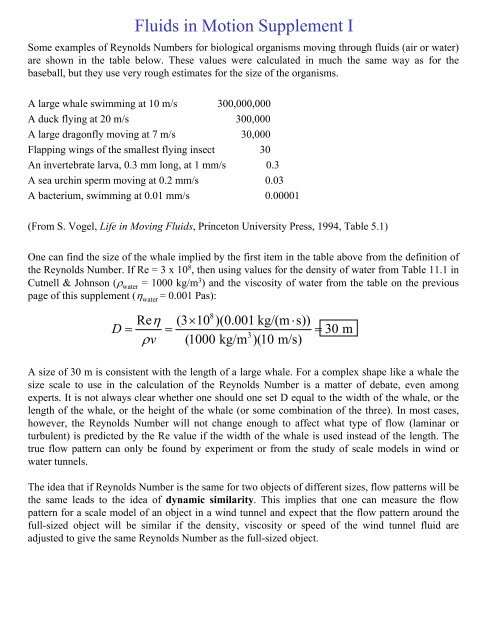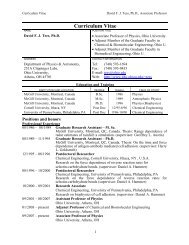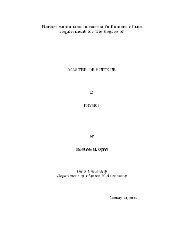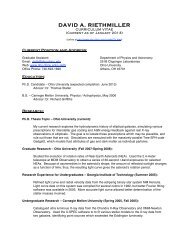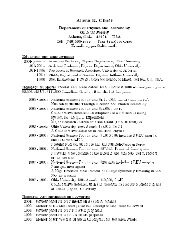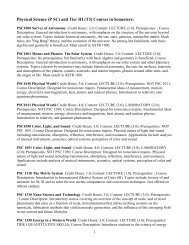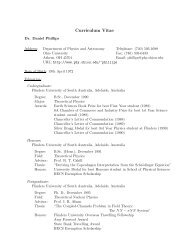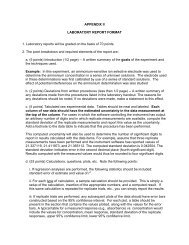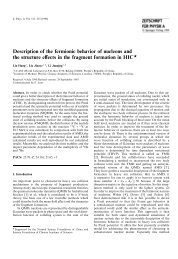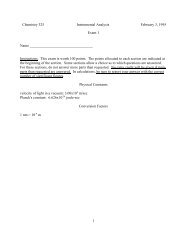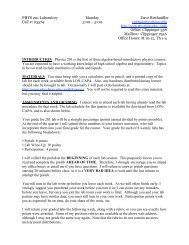Fluids in Motion Supplement I
Fluids in Motion Supplement I
Fluids in Motion Supplement I
Create successful ePaper yourself
Turn your PDF publications into a flip-book with our unique Google optimized e-Paper software.
<strong>Fluids</strong> <strong>in</strong> <strong>Motion</strong> <strong>Supplement</strong> I<br />
Some examples of Reynolds Numbers for biological organisms mov<strong>in</strong>g through fluids (air or water)<br />
are shown <strong>in</strong> the table below. These values were calculated <strong>in</strong> much the same way as for the<br />
baseball, but they use very rough estimates for the size of the organisms.<br />
A large whale swimm<strong>in</strong>g at 10 m/s 300,000,000<br />
A duck fly<strong>in</strong>g at 20 m/s 300,000<br />
A large dragonfly mov<strong>in</strong>g at 7 m/s 30,000<br />
Flapp<strong>in</strong>g w<strong>in</strong>gs of the smallest fly<strong>in</strong>g <strong>in</strong>sect 30<br />
An <strong>in</strong>vertebrate larva, 0.3 mm long, at 1 mm/s 0.3<br />
A sea urch<strong>in</strong> sperm mov<strong>in</strong>g at 0.2 mm/s 0.03<br />
A bacterium, swimm<strong>in</strong>g at 0.01 mm/s 0.00001<br />
(From S. Vogel, Life <strong>in</strong> Mov<strong>in</strong>g <strong>Fluids</strong>, Pr<strong>in</strong>ceton University Press, 1994, Table 5.1)<br />
One can f<strong>in</strong>d the size of the whale implied by the first item <strong>in</strong> the table above from the def<strong>in</strong>ition of<br />
the Reynolds Number. If Re = 3 x 10 8 , then us<strong>in</strong>g values for the density of water from Table 11.1 <strong>in</strong><br />
Cutnell & Johnson (ρ water = 1000 kg/m 3 ) and the viscosity of water from the table on the previous<br />
page of this supplement (η water = 0.001 Pas):<br />
8<br />
Re η (3× 10 )(0.001 kg/(m ⋅s))<br />
D = = = 30 m<br />
3<br />
ρv<br />
(1000 kg/m )(10 m/s)<br />
A size of 30 m is consistent with the length of a large whale. For a complex shape like a whale the<br />
size scale to use <strong>in</strong> the calculation of the Reynolds Number is a matter of debate, even among<br />
experts. It is not always clear whether one should one set D equal to the width of the whale, or the<br />
length of the whale, or the height of the whale (or some comb<strong>in</strong>ation of the three). In most cases,<br />
however, the Reynolds Number will not change enough to affect what type of flow (lam<strong>in</strong>ar or<br />
turbulent) is predicted by the Re value if the width of the whale is used <strong>in</strong>stead of the length. The<br />
true flow pattern can only be found by experiment or from the study of scale models <strong>in</strong> w<strong>in</strong>d or<br />
water tunnels.<br />
The idea that if Reynolds Number is the same for two objects of different sizes, flow patterns will be<br />
the same leads to the idea of dynamic similarity. This implies that one can measure the flow<br />
pattern for a scale model of an object <strong>in</strong> a w<strong>in</strong>d tunnel and expect that the flow pattern around the<br />
full-sized object will be similar if the density, viscosity or speed of the w<strong>in</strong>d tunnel fluid are<br />
adjusted to give the same Reynolds Number as the full-sized object.


